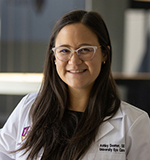THE SHIFT FROM health care student to practicing clinician is a significant period in one’s career. Moving from the guidance of professor-mentors and preceptors in academia to self-resilience in the professional setting can be challenging. As an optometrist, I have navigated this transition myself and as an assistant professor at Marshall B. Ketchum University’s Southern California College of Optometry, I am now able to assist my students as they move through it on their own. Based on this experience, I believe there are several key steps new health care providers can take to navigate this progression seamlessly.
Find Ways to Stay in the Community
While receiving an education, you are naturally connected to peers in a classroom setting, fostering a supportive community vital for the challenges health care education brings. However, after graduation, professional life can feel isolating. To counter this, I recommend staying connected with peer groups and creating a community of your own. For instance, after optometry school, my classmates and I created a group chat, providing a space for idea exchange and mutual support during our transition.
Additionally, it’s beneficial to integrate into established professional communities. This could involve staying in touch with former mentors or engaging more with professional organizations. Drawing from experienced professionals not only offers insight into common challenges but also provides networking opportunities and helps maintain passion for the field while warding off burnout.
Advertisement
Consider Doing a Residency
While not for everyone, considering a residency program is a wise choice in health care. In optometry, such a program offers a year of intensive clinical practice, exposing you to complex and diverse cases early on. This structured environment within an academic institution provides a crucial advantage in the smooth transition to becoming a practicing health care professional.
Stay on Top of Your Schedule
While clinics often require new doctors to start with a full patient schedule immediately, I recommend a slower ramp-up if possible. This allows you to get acclimated to non-clinical aspects of practice, such as logistical management, which is essential for efficient patient care integration. Prioritizing thorough preparation each day, including adequate time for chart review and planning for additional testing or resources, ensures readiness for patient care. Additionally, reviewing each patient after their visit helps solidify care management.
Adopt the Mindset of a Lifelong Learner
Even as you conclude your studies, I believe it is essential to embrace lifelong learning in your discipline. While initial complacency may not set in immediately, experience accumulates rapidly, potentially leading to you becoming content with your skillset early on. However, health care fields are ever-evolving, which is why it is important to stay abreast of change and innovation through continuing education or professional development. Depth of knowledge is a powerful asset during the transition to professional practice.
Lastly, trust yourself. Embarking on your career after education can feel daunting, especially when faced with heavy workloads and independence. However, your journey thus far attests to your knowledge, work ethic and passion. Trust your instincts, seek support when needed and actively pursue a deeper engagement in your profession for a seamless transition from academia to practice.
About the Author

Ashley Deemer
Ashley Deemer, OD, FAAO at Marshall B. Ketchum University earned her undergraduate degree from the University of California San Diego and her Doctor of Optometry degree from the New England College of Optometry. Following this, she completed residency training at the Jamaica Plain Veterans Affairs Medical Center in Boston, MA, specializing in primary care optometry, low-vision rehabilitation and vision therapy. Deemer further honed her expertise through the Lions Vision Rehabilitation Fellowship at the Johns Hopkins Wilmer Eye Institute in 2016.
During her training, Deemer received prestigious scholarships such as the Charles Robert Soltes, Beider and Bill Mattingly Memorial Scholarships. She was also recognized with grant awards for her research focusing on functioning outcome measures and depression prevention in patients with age-related macular degeneration. Currently, her research interests are in developing and implementing low-vision enhancement systems using head-mounted video displays and virtual reality.
Previously, Deemer practiced at the Johns Hopkins Wilmer Eye Institute, specializing in low-vision rehabilitation to optimize sight for patients with chronic visual impairment. She is also a Fellow of the American Academy of Optometry.